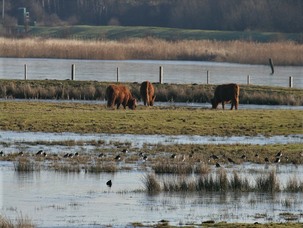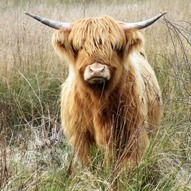

Biodiversity
Action
Plan

Floodplain Grazing Marsh consists of pastures or meadows in river floodplain areas that are periodically inundated or have a high water-table; they are often criss-crossed by ditches which retain water and dampness.
In the Dearne Valley, Floodplain Grazing Marsh sites have shallow subsistence flashes and excavated pools in wet grassland. In winter time they are extensively flooded for overwintering species. They have ditches, foot-drains and scrapes to retain water in the damp grassland. The water levels are in part controlled by the use of sluices and sometimes pumps.
Most sites have an important role in flood defence, being used by the Environment Agency as washlands or flood reservoirs, the sites filling to capacity when the river is high and settlements are at risk of flooding.
Floodplain Grazing Marsh - the combination of wet grasslands and shallow open water with muddy areas - supports a range of wildlife.
Grazing Marshes are particularly important for the breeding waders such as Lapwing, Redshank and Snipe, and when more extensively flooded with shallow water in winter months, they support over-wintering wildfowl such as Wigeon and Teal in high numbers.
Priority habitat
Floodplain Grazing Marsh is a UKBAP national priority habitat and S41 Habitat of Principal Importance [UKHab g3c(25)]
It is wet neutral grassland and/or marshy grassland in Phase 1 habitat surveys.
Neutral Grassland or Lowland Meadow, another national priority habitat, includes seasonally inundated wet grassland and floodplain meadows.
The National Vegetation Classification identifies the following plant communities for inundated grassland:
MG4 Burnet floodplain meadow
MG5 Knapweed meadow
MG7 Foxtail grassland
MG11 Silverweed pasture.
The distinguishing features for Floodplain Grazing Marsh are its open water features and muddy areas and its management to maintain these features and the wildlife species they support.
Floodplain Grazing Marsh is a local priority habitat because of its national status and scarcity, the wildlife it supports -especially breeding and wintering birds- and opportunities for conservation.
The wet grassland of Floodplain Grazing Marsh is found on alluvial soils in river floodplain areas. It is dependent on periodic inundation and high but seasonally variable water levels.
It is sustained after winter flooding by a summer hay-cut and consequent grazing, or spring and summer grazing.
Grazing Marsh does not itself have extensive areas of tall fen species like reeds but is part of the mosaic of wetland habitats with open water, fen and reedbed.
For more information on Floodplain Grazing Marsh,follow these links:



Floodplain grazing marsh